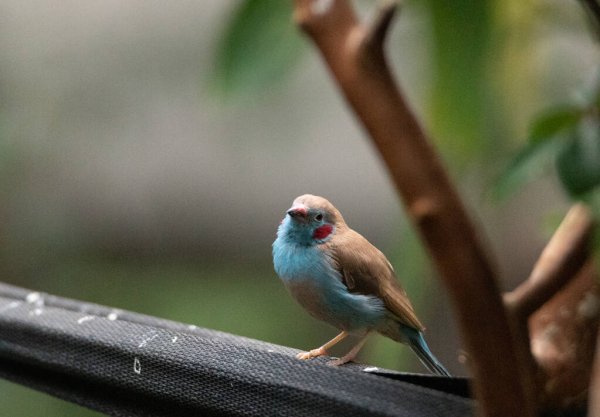ANIMAL: Red-Cheeked Cordon-Bleu Uraeginthus bengalus Type of Animal: Songbird Habitat: Grassland, savanna, areas near human habitation, bush, wooded areas/woodland, cultivated lands, suburban gardens, thornscrub, villages, scrub, low grasses w/ tangled undergrowth, dry acacia woodland, roadsides, found from sea level to 7,970 ft Location(s): Native to Sub-Saharan Africa. Introduced to Hawaii’s Big Island & Oahu. Appearance: Male has uniformly brown upper area, pale blue breast/flanks/tail, yellow belly, red patches on cheeks, females lack cheek patches & have same coloration as males but duller, juveniles look like females but only have blue in face/throat Food/Diet: Seeds, grains, beeswax, insects, insect larvae/eggs, greens, green vegetables, corn, fruit, dandelion, chickweed Status in Wild: Stable Conservation: Breeding in zoos & aviculture Lifestyle: Small flocks of 2-10 birds. Often nest as single pairs but sometimes nest in proximity to conspecifics. Additional Info: Called: Male: Cock Female: Hen Young: Chick Group: Flock Weight: 0.32-0.37 oz Gestation: 2 weeks Life Span: 7-9 years Body Length: 4.9-5.1 in Tail Length: 0.7 in Main predators are monkeys, birds, snakes, lizards, & ants. Nests are large domed grass structures w/ side entrances built on trees/bushes/thatches. Females usually lay 4-6 eggs. Chicks leave nest at 1.5 months old. Sexually mature at 6 months old. Larger grain-eating birds (especially whydahs) often chase smaller cordon-bleus away from food sources. Fairly popular in the pet trade. Sometimes hybridize w/ other finch species. Both sexes sing but males sing more than females. Can breed up to 3 times a year. Also called Red-Cheeked Blue Waxbill. Often feed on the ground. These finches are sensitive to nest disturbances. These birds breed throughout the year but more often in rainier periods. Fun Fact(s): Often drink by sucking up water & appear to love baths. Males often take part in “sexual chasing,” in which male chases/pecks female-especially when interrupted by rival male. Bengalus part of scientific name based on erroneous belief that species came from Bengal region of S Asia. These birds are not shy & often seen/found near human areas.

